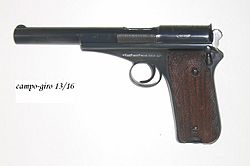Campo Giro facts for kids
Quick facts for kids Pistola Campo-Giro de 9mm Modelo 1912Pistola Campo-Giro de 9mm Modelo 1913 Pistola Campo-Giro de 9mm Modelo 1913–1916 |
|
|---|---|

Campo-Giro Modelo 1913–1916
|
|
| Type | Semi-automatic pistol |
| Place of origin | Spain |
| Service history | |
| In service | 1912–1921 |
| Used by | Spain |
| Wars |
|
| Production history | |
| Designed | 1904 |
| Produced | 1912–1919 |
| No. built |
|
| Specifications | |
| Cartridge | 9 mm Largo |
| Caliber | 9mm |
| Action | delayed blowback |
| Feed system | 8-round magazine |
The Campo-Giro was a type of semi-automatic pistol. This means it could load a new bullet automatically after each shot. It used a special bullet called the 9mm Largo cartridge. This pistol was used by the Spanish military. It was named after its designer, Colonel Don Venancio López de Ceballos y Aguirre, who was also known as the Count of Campo-Giro.
Contents
Who Was Campo-Giro?
Venancio López de Ceballos y Aguirre was born in 1856 in a place called Peñacastillo, in Spain. He joined the Military Cavalry Academy in 1876. He was a very good student and graduated as a second lieutenant in 1879, being first in his class.
He continued his military education and became a staff lieutenant in 1885. He held many different jobs in the army. In 1893, he was sent to Melilla, a Spanish city in North Africa. The next year, he became a major. In 1895, he went to Cuba to be a Chief of Staff for a military group. He was there during the Spanish–American War. After his service in Cuba, he was honored for his work.
When he returned to Spain, he was elected to the Spanish parliament. In 1905, he officially retired from the army. However, he was promoted to lieutenant colonel in 1909 and returned to active duty in 1911. He finished his military career in 1912, working for a general.
How the Pistol Was Developed
Campo-Giro started designing firearms even before he fully retired. In 1904, he received his first patent for "An automatic pistol of 9mm calibre of a new system." A patent is like an official document that says you invented something.
In 1911, he got another patent for a self-loading rifle, called a carbine. Then, in 1912, he got a special design registration for his pistol. Later that year, he got another patent for his pistol. This new design included a "shock-absorber" to help with the gun's kick when it fired.
The Spanish army decided to use this pistol in 1912. They called it the Pistola Campo-Giro de 9mm Modelo 1912. Before this, the army used a different pistol called the Bergmann–Bayard. That pistol wasn't very good during the early wars in Morocco. However, the 9mm Largo bullet used by both pistols was considered successful. The first Campo-Giro pistols were made in a factory in Oviedo, Spain. The design was seen as modern and strong, and the pistol was widely tested.
Making the Campo-Giro Pistols
After some Modelo 1912 pistols were made, the army learned about an improved version. In January 1914, this new version was adopted. It was called the Pistola Campo-Giro de 9mm Modelo 1913.
The Model 1913 pistols were made by a company called Esperanza y Unceta. Because the army ordered so many, the company moved to a bigger factory in Guernica. In 1914, about 1,300 of these pistols were made. Then, production stopped to add even more improvements.
The Modelo 1913 had a special design called "delayed blowback." This is a clever way to handle the strong kick of a powerful bullet like the 9mm Largo. The Campo-Giro used a strong spring to absorb the recoil. It also had a smaller spring under the barrel. This smaller spring acted like a shock absorber and helped delay the gun's action.
Like the older Bergmann–Bayard, it had an external hammer and bullets ejected from the top. But the Campo-Giro's magazine (where the bullets are stored) was in the handle. This allowed for a much longer barrel. The pistol was quite large, over 225mm (9 inches) long. It weighed more than 900 grams (2 pounds) when empty. It held 8 bullets in its magazine. Because of its longer barrel, the bullets fired from the Campo-Giro traveled faster than those from the Bergmann–Bayard. The pistol was well-made and accurate, but it was hard to take apart.
Campo-Giro continued to improve his design. He got new patents in 1913, 1914, and 1915. These changes included a new frame, a redesigned mainspring, and moving the magazine release to the bottom of the handle.
During the First World War, it became hard to get the special black buffalo horn used for the pistol grips. So, wood was used instead. The improved model was adopted in September 1916. It was named the Pistola Campo-Giro de 9mm, Modelo 1913-16.
However, by 1919, the Spanish military started looking for another new pistol. But they didn't look far! The Campo-Giro was the direct ancestor of the Astra Modelo de 1921/Model 400. These newer pistols were later adopted by the army. Even though the Campo-Giro was officially replaced, many were used again during the Spanish Civil War. Sadly, Campo-Giro did not live to see how successful his pistol would become. He died after a horse riding accident in Madrid on May 22, 1916.
Images for kids
See also
 In Spanish: Pistola Campo Giro para niños
In Spanish: Pistola Campo Giro para niños


